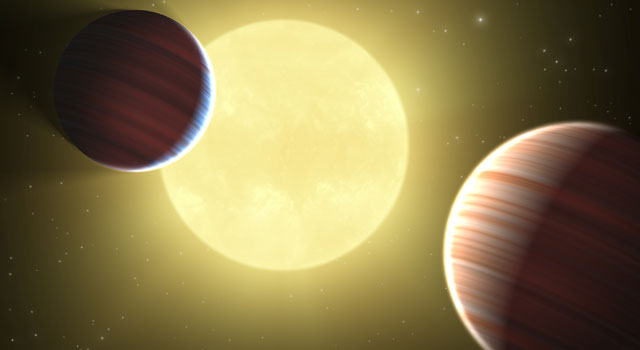Kepler Mission Unveils Two Planets in Transit Around a Single Star
NASA’s Kepler spacecraft has made a groundbreaking discovery – the first confirmed planetary system with multiple planets crossing in front of the same star. This remarkable finding was made through the observation of two distinct planets, named Kepler-9b and 9c, in the data collected from the sun-like star Kepler-9. Over a period of seven months, more than 156,000 stars were observed as part of an ongoing search for Earth-sized planets beyond our solar system. The results of this discovery will be published in the upcoming issue of the prestigious journal Science.Kepler’s highly precise camera is able to detect minuscule decreases in the brightness of stars when a planet passes in front of them. By analyzing these temporary dips, scientists can determine the size of the planet.
Additionally, the distance between a planet and its star can be calculated by measuring the time between successive dips, as the planet orbits around the star. By studying the regularity of these dips, scientists can also determine the masses of the planets and even detect other planets within the system that do not transit in front of the star.
In June 2010, the Kepler mission scientists submitted their initial findings for peer review, which identified over 700 potential planets within the first 43 days of Kepler data. Among these candidates, five systems showed evidence of multiple transiting planets. Recently, the Kepler team discovered a sixth system with multiple transits and gathered enough follow-up data to confirm the existence of this multi-planet system.
Doug Hudgins, the Kepler program scientist at NASA Headquarters in Washington, expressed the significance of Kepler’s high-quality data and continuous monitoring of transiting objects. This enables scientists to make unique measurements of the parent stars and their planetary systems, providing invaluable insights into the nature of these distant worlds.

The masses of the planets have been refined by scientists using data from the W.M. Keck Observatory in Hawaii. Based on the observations, it has been determined that Kepler-9b is the larger of the two planets, and both planets have masses similar to, but less than, Saturn. Kepler-9b is located closest to the star and has an orbit of approximately 19 days, while Kepler-9c has an orbit of about 38 days. By studying the transits of each planet over a period of seven months, scientists were able to analyze the time between successive transits.
According to Matthew Holman, a Kepler mission scientist from the Harvard-Smithsonian Center for Astrophysics in Cambridge, Mass., this discovery represents the first clear detection of significant changes in the intervals between planetary transits, known as transit timing variations. It provides evidence of the gravitational interaction between the two planets as observed by the Kepler spacecraft.
In addition to the two confirmed giant planets, the Kepler scientists have also identified a potential third transit signature in the observations of Kepler-9. This signature is consistent with the transits of a super-Earth-sized planet, approximately 1.5 times the radius of Earth, in a scorching orbit that takes only 1.6 days to complete. Further observations are necessary to determine whether this signal is indeed a planet or an astronomical phenomenon that mimics the appearance of a transit.
This article is republished from PhysORG under a Creative Commons license. Read the original article.
Do not forget to share your opinion with us to provide you with the best posts !



0 Comments